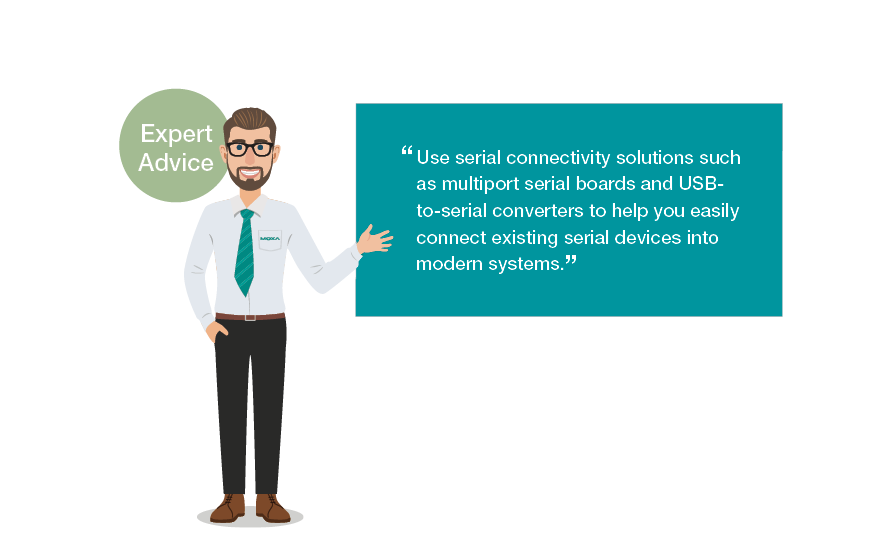If your long-serving serial-based machinery or gadgets have been the backbone of your business for years, you may be pondering how much longer you can maintain these assets. Computers nowadays lack serial ports, and operating systems are undergoing more frequent updates, leading to increased diversity. Additionally, the trend of managing assets online is growing rapidly, allowing for quick access to information and reducing response times while generating valuable data for business insights, thereby enabling more efficient business operations. All these aspects are intertwined with the concept of connectivity. On your journey toward connectivity, two key inquiries emerge. How can your aging serial devices integrate with modern systems when serial ports are no longer a standard feature on computers? How can you facilitate remote management for devices that lack Ethernet interfaces?
To streamline data acquisition, production equipment and monitoring sensors have been upgraded with Ethernet interfaces, simplifying connectivity and data collection. However, this advancement often necessitates hefty investments in connectivity to leverage the benefits. Nonetheless, the preservation of your serial devices should not merely be driven by sentimental reasons but also by the desire to safeguard your valuable investment by enhancing the capabilities of these devices. Fortunately, a range of solutions for serial connectivity offer straightforward and cost-effective upgrades to bridge the gap between your legacy devices and future networking requirements. In this piece, we illuminate three principal challenges you might encounter when enabling serial connectivity between your legacy devices and contemporary systems. Moreover, we offer expert advice to streamline your upgrade process.
Challenge 1
Scarce Serial Interfaces in Modern Computers
Computers are frequently employed in industrial settings to interface with diverse devices. However, the traditional RS-232, RS-422, and RS-485 interfaces are now seldom found on newer computers, making it challenging to connect serial devices at remote sites to central control hubs. Fortunately, this issue can be rectified by integrating expansion cards, such as PCI, PCIe, mini-PCIe, etc., at the motherboard level to augment the number of serial ports on an industrial PC. Alternatively, since USB interfaces have become standard on present-day computers and laptops, USB-to-serial converters offer a viable solution to address the dearth of connectivity on host computers.

Challenge 2
Challenges in Enabling Remote Monitoring via Serial Communications
As applications scale up, remote communication becomes crucial from a management perspective, with serial-based communication posing inherent difficulties. Ethernet communication has gained prominence for facilitating remote monitoring applications. Hence, serial-to-Ethernet converters present a cost-effective means of enabling Ethernet connectivity for your serial devices. However, the conversion of serial communication data to Ethernet format may not be straightforward, as network architecture and software compatibility issues may arise. Adapting to this new communication interface and data interpretation would likely entail recalibrating your original serial communication protocols, such as creating virtual COM ports for accessing serial devices over TCP/IP-based networks. Moreover, the transition from serial communication protocols like Modbus RTU to Ethernet protocols like Modbus TCP requires additional effort. To seamlessly integrate your serial devices into Ethernet-capable systems, opt for a serial-to-Ethernet converter that simplifies communication setup, saving you valuable time. Additionally, ensure that your chosen serial-to-Ethernet converter is supported by drivers compatible with your preferred operating system.

Challenge 3
Unpredictable Availability of Serial Connectivity Components
While various solutions exist to extend the utility of your valuable assets, the ongoing availability of serial connectivity solutions assumes paramount importance in the long haul. Selecting a dependable component supplier is critical, as their ability to provide sustainable serial connectivity solutions can significantly impact the durability of your serial-based equipment. Furthermore, as technology evolves, new challenges emerge. Consequently, your connectivity solutions must evolve correspondingly. For instance, the escalation of cyber threats within connected environments poses a significant risk to your business operations. Therefore, cybersecurity emerges as a pivotal consideration for devices equipped with network interfaces. Committing to long-term investments in serial connectivity solutions that offer both durability and technological advancement affords you confidence that your business operations will continue seamlessly for years to come.

Your Reliable Ally for Serial Connectivity Solutions
To surmount these challenges in serial communication, Moxa’s suite of serial connectivity solutions ensures effortless integration of your serial devices. Our array of serial connectivity products encompasses multiport serial boards, USB-to-serial converters, serial device servers, and serial-to-Ethernet protocol gateways, catering to diverse connectivity requirements for integrating your serial devices into modern systems. With support for a variety of operating systems and their latest iterations, such as Windows, macOS, and Linux, our serial connectivity solutions make it seamless to align your serial devices with a broad spectrum of operating environments.
Having delivered serial connectivity solutions for over three decades, Moxa remains steadfast in providing innovative serial connectivity solutions that align with your future networking needs for the forthcoming decades. Explore our dedicated microsite to delve deeper into our commitment and investment in cutting-edge serial connectivity solutions.
- Not Only for Automobiles: Discovering CANbus Technology in Various Industrial Settings - October 29, 2024
- Boost Your Network Performance: An Exciting Manual to PoE Switches! - September 10, 2024
- Understanding Gigabit Switches: Industrial vs Regular Gigabit - September 4, 2024


